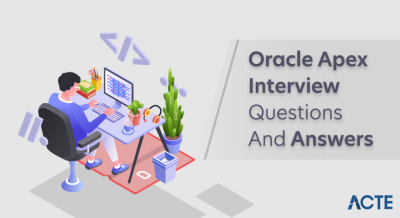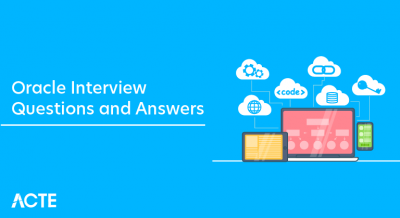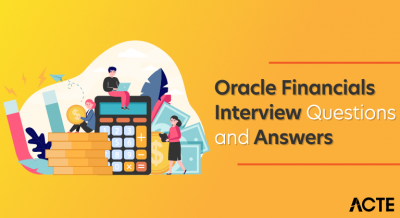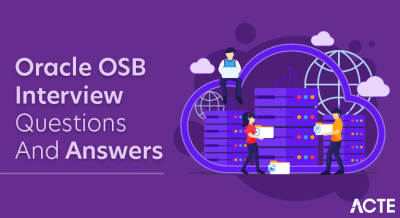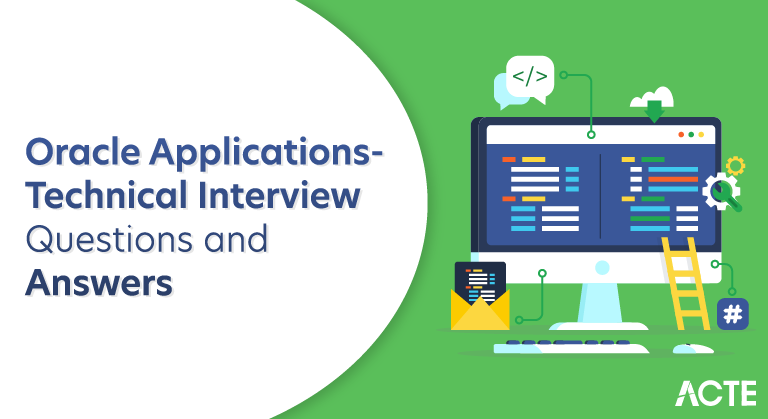
Oracle provides a comprehensive suite of enterprise applications catering to various business needs. These applications include Oracle E-Business Suite (EBS) for managing core operations, Oracle ERP Cloud offering cloud-based enterprise resource planning, Oracle HCM Cloud for human capital management, Oracle CX Cloud focusing on customer experience, and Oracle SCM Cloud addressing supply chain management. These solutions cover functions like financials, HR, customer experience, and supply chain, enabling businesses to streamline operations, manage resources, and enhance customer relationships. Oracle’s diverse applications are designed to support the complexities and demands of modern enterprises.
1. What is Oracle Apps Technical?
Ans:
Oracle Apps Technical refers to the technical aspects of the Oracle Applications, including the customizations, extensions, and integrations, to meet a specific business requirements.
2. What are the key components of Oracle Apps Technical?
Ans:
The key components of Oracle Apps Technical included: Oracle Forms, Reports, PL/SQL, Workflow, Application Object Library (AOL).
3. How does one handle customization conflicts during Oracle Apps upgrades?
Ans:
To handle customization conflicts, it’s important to document all the customizations, conduct impact analysis, and follow the Oracle’s best practices for customization, are using personalizations over a custom code modifications whenever possible.
4. How do you troubleshoot performance issues in Oracle Apps Technical?
Ans:
To troubleshoot performance issues, can analyze the SQL queries, check database indexing, review a concurrent program settings, utilize Oracle diagnostic tools, and optimize the configuration of the Oracle Apps components.
5. What does Value Set in Oracle Apps, and why does important?
Ans:
A Value Set is the list of predefined values used to restrict an input for a specific field. It ensures a data integrity and helps enforce data validation rules by allowing only valid values to be entered.
6. What is the difference between a value set and a validation table in Oracle Apps?
Ans:
| Aspect | Value Set | Validation Table | |
| Purpose |
Defines permissible values for a specific attribute or segment |
Stores lists of values used for validation in flexfields and applications | |
| Usage | Used for defining value ranges or formats for data entry | Employed for the validation of data in flexfields and other applications | |
| Structure | Contains a list of values or a set of rules and conditions | Stores values, their meanings, and related attributes |
7. What does Oracle E-Business Suite?
Ans:
Oracle E-Business Suite (EBS) is the comprehensive suite of integrated business applications offered by an Oracle Corporation. It includes the wide range of software modules to support the various business processes within an organization.
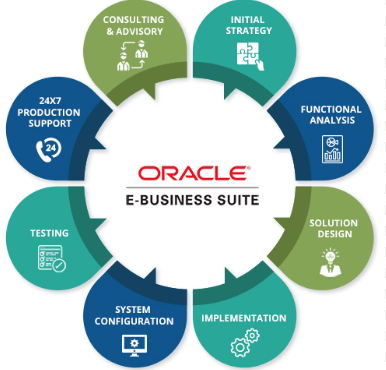
8. What is the Oracle Concurrent Program, and how does create one?
Ans:
An Oracle Concurrent Program is the program that runs in a background to perform specific tasks. It can be created using “Concurrent Programs” window in Oracle Apps and specifying program’s executable, parameters, and the other settings.
9. How does debug Oracle Apps Technical code?
Ans:
Oracle Apps Technical code can be debugged using the various methods, including the placing debug messages in code, using the “Debug” profile option, setting breakpoints in the Oracle Forms, or using the logging and tracing mechanisms.
10. How does one create a custom table in Oracle Apps?
Ans:
To create the custom table, need to define a table structure using SQL DDL statements, including the column definitions, constraints, and indexes. Afterward, can register the table in Oracle Apps using “Application Developer” responsibility.
11. What is the difference between a Key Flexfield and a Descriptive Flexfield?
Ans:
A Key Flexfield (KFF) is the predefined structure used to capture a key information, such as account codes or item codes. A Descriptive Flexfield (DFF) provides additional customizable attributes to be capture additional information based on the business requirements.
12. How does extend Oracle Apps functionality using Oracle Application Framework (OAF)?
Ans:
Oracle Application Framework (OAF) allows the developers to create a custom pages and components within an Oracle Apps. By leveraging OAF, can extend the application’s functionality to meet a specific business needs.
13. How does data conversion/migration in Oracle Apps Technical?
Ans:
Data conversion/migration in the Oracle Apps Technical involves an extracting data from the source system, transforming it according to target system’s requirements, and loading it into an appropriate tables using SQL scripts, PL/SQL packages, or data import tools provided by the Oracle.
14. What are Set-of-Books?
Ans:
A Set of Books refers to the financial reporting structure that allows organization to maintain the multiple sets of accounting records within single database. Each set of books represents the self-contained financial entity, with its own chart of accounts, calendar, and accounting rules.
15. What two parameters are mandatory for pl/sql type concurrent program?
Ans:
Procedure/function (ERRBUF OUT RETCODE OUT ………………….)
- ERRBUF: Used to write an error message to log or request file.
- RETCODE: Populate a log request file with the program submission details info.
16. What does Value Set?
Ans:
- Whenever the value set associated with the any report parameters. It provides the list of values to the end-user to accept one of the values as a report parameter value.
- If the list of values needed to be a dynamic and ever-changing and define the table based values set.
17. What are validation types?
Ans:
- None
- Independent
- Dependent
- Table
18. What is a Template?
Ans:
The TEMPLATE form is a required starting point for all the development of new Forms, The TEMPLATE form includes the platform-independent attachments of a several Libraries.
19. What do ad-hoc reports?
Ans:
Ad – hoc Report is made to meet a one-time reporting needs. Concerned with or formed for the particular purpose. For example, ad hoc tax codes or ad hoc database query.
20. What is responsibility?
Ans:
- Menus: A collection of forms is nothing but a menus
- Request security groups: A collection of the programs.
- Data groups: Is group of modules to be made accessible by a user through Responsibility System admin
21. How does one customize a standard Oracle form?
Ans:
Customizing the standard Oracle form can be done using the personalizations, which allow changes without modifying underlying code. A Personalizations can achieved through a Forms Personalization feature.
22. What does multi-org?
Ans:
“Multi-org” refers to a system or feature that enables the management of multiple independent organizations or entities within a unified environment. This could apply to software systems, databases, or organizational structures, allowing different entities to operate separately yet within the same overarching system, often ensuring some level of autonomy or segregation.
23. What does ERP?
Ans:
A packaged business software system that lets the company automate and integrate the majority of its business processes; share the common data and practices across the enterprise; [and] produce and access information in the real-time environment.
24. What is Data Link?
Ans:
Data links relate to be results of the multiple queries , A data link (Parent-Child Relation Ship) causes a child query to be executed once for every instance of its parent group.
25. In which tables FF are stored?
Ans:
- FND – ID – FLEX
- FND-ID-FLEX-STRUCTURES 5,/li>
26. What does Oracle Applications Architecture?
Ans:
The Oracle Applications Architecture is a structured suite of software solutions by Oracle, serving diverse business functions like ERP, CRM, and supply chain management. Offering integration capabilities and customization, it ensures scalability, performance, robust security, and access control. Continuously evolving, it adapts to technological advancements, catering to varying business needs for efficient enterprise solutions.
27. How does call WHO columns into the form?
Ans:
In an Oracle form, calling WHO columns involves modifying the database table to include ‘Created By,’ ‘Creation Date,’ ‘Last Updated By,’ and ‘Last Update Date’ columns. These columns are then integrated into the form design and associated with relevant data blocks or fields.
28. What does APPCORE API?
Ans:
- APP_COMBO
- APP_DATE
- APP_EXCEPTION
- APP_FIELD
- APP_FIND
29. what does FNDSQF API?
Ans:
- FND_CURRENCY
- FND_DATE
- FND_GLOBAL
- FND_ORG
30. How does register a table and columns through back end?
Ans:
Registering a table and its columns through the backend involves utilizing SQL commands within a database management tool or interface. Using the ‘CREATE TABLE’ SQL statement, the database administrator defines the table’s name and outlines each column along with its data type and constraints, such as primary keys or unique constraints.
31. How does register a table and columns through back end?
Ans:
The absence of data when querying a multi-org view within systems like Oracle can stem from various factors. Firstly, incorrect or missing specification of the organization context in the query could result in a lack of retrieved information. This multi-org architecture relies on setting the appropriate organizational context for data retrieval, and overlooking this parameter might lead to an empty result set.
32. How does find that multiorgan is installed?
Ans:
Identifying the presence of a multi-org configuration, such as in systems like Oracle, can be achieved through various means. Firstly, examining system documentation or configuration files often explicitly mentions the installation or activation of a multi-org setup.
33. What does Handlers?
Ans:
- Handlers provide the way to centralize the code so that it becomes simpler to develop, maintain, and debug.
- The packaged the procedures available in handler are called from the triggers by passing a name of the trigger as an argument for procedure to process.
34. What does types of Handlers?
Ans:
- Item Handlers
- Event Handlers
- Table Handlers
- Business Rules
35. What does Data Group?
Ans:
- A data group is the group of Oracle applications and Oracle ID’s of each application
- Oracle ID grants the access privileges to tables in Oracle Database
36. What does security Attributes?
Ans:
Security Attributes are used by the Oracle self-service web Applications to allow the rows of data to be visible to the specified users’ responsibilities based on specific data contained in a row.
37. What does Profile Option?
Ans:
Profile options are the set of changeable options that affect how application looks and behaves, by setting the profile options, the applications can be made to react in the various ways for different users depending on a specific user attributes
38. What does steps involved in developing a flex field?
Ans:
- Designing a table structure
- Creating fields on form (Visible/Hidden)
- Calling an appropriate routines
- Registration of a flex field.
- Definition of flex field
39. What does relation between Responsibility, Menu, and Request Group?
Ans:
Responsibility: A responsibility is the set of authority in Oracle Apps that lets users access only that functionality of application appropriate to their roles.
Menu: A menu is the hierarchical arrangement of functions and menus of functions that appears in Navigator. Every responsibility has menu assigned to it.
Request Group: It is a collection of rthe eports or concurrent programs. A System Administrator defines a report groups in order to control the user access to reports and concurrent programs.
40. What does function, How to create one?
Ans:
A function is the part of an application’s functionality that is registered under unique name for the purpose of assigning to it to or excluding it from, a menu (and by extension, responsibility). There are the several types of functions: – Form Functions, SubFunctions, and Non-form functions. Often refer to the form function simply as a form.
41. What does meant by APPL_TOP?
Ans:
An environment variable that denotes installation directory for the Oracle Application Object Library and the other Oracle applications. $APPL_TOP is usually one directory level above each of a product directories (which are often referred to as the $PROD_TOP or $PRODUCT_TOP or $_TOP).
42. When does Custom. pll used?
Ans:
CUSTOM.PLL is the custom library in Oracle Forms, which allows the developers to define a custom triggers, procedures, and functions to enhance the functionality of the Oracle Forms applications. This library is typically used when need to implement a specific business logic or customize behavior of Oracle Forms modules.
43. What does levels can these be set in profile option?
Ans:
System Profile: The profile option can be set for a user community.
User Profile: Provide Oracle Apps with the standard information that describes a user, Application, Responsibility, and site. At every profile level, user profile options can be set.
44. How does know the form (FMB) name when can open a form in Apps?
Ans:
Identifying the specific .FMB (Form Module Binary) file name while opening a form in Oracle Applications isn’t immediately evident within the user interface. Navigate through the application menus to access the desired form. Within the form, examine the ‘Help’ or ‘About’ section to find ‘Form Properties’ or ‘Module Information’ where the form name might be displayed.
45. Where does create a table and sequence in Apps? Is it an APPS schema?
Ans:
Oracle E-Business Suite uses the specific data model and architecture, and customizations to database schema are usually done through the Oracle Application Object Library (AOL) or Oracle Application Development Framework (ADF) technologies. Custom objects are tables, sequences, and views are created using Oracle Application Object Library (AOL) and Oracle Forms Personalization.
46. Where does Views and Procedures created?
Ans:
Views: Views are to be created only in the APPS.
Procedures: In custom schema and the grant it to be APPS schema.
47. How Can create new profiles ? If so how?
Ans:
Creating new profiles within a system, such as Oracle Applications, typically requires administrative access. Upon logging in with administrative privileges, navigate to the profile management section within the system’s administrative interface. Look for an option to “Create New Profile” or similar, where you can define the profile’s name and configure specific settings, including access rights and permissions.
48. What does approach to create a new form to be used in Oracle Apps?
Ans:
The TEMPLATE form is a required starting point of all development of the new forms. Start Developing every new form by copying the TEMPLATE.FMB file, located in $AU_TOP/forms/US(or language and platform equivalent), to the local directory and Rename it as appropriate.
49. What does approach to create a new form to be used in Oracle Apps?
Ans:
In Oracle E-Business Suite, Independent Value Sets contain predefined values managed within the value set, providing a static list that isn’t tied to external tables. They offer a self-contained set of values specifically defined within the flexfield. In contrast, Table Validated Value Sets validate values against an external table’s column in the Oracle Applications database, allowing dynamic validation against data stored externally. This approach enables a more flexible and expandable validation process as it directly references and validates values from external sources, offering greater scalability and adaptability for value management within the system.
50. What does difference between the Operating Unit and Inventory Organization?
Ans:
Operating Units in Oracle E-Business Suite represent financial reporting entities, managing financial and legal reporting across business functions. Inventory Organizations, however, are specific units focused on inventory-related activities like stocking and managing goods. Operating Units primarily handle financial control and reporting, while Inventory Organizations manage inventory-specific tasks such as stock movements and warehouse management within the system.
51. What does Item Validation Organization?
Ans:
The organization that contains the master list of items. Define it by setting OM: Item Validation Organization parameter. Must define all items and bills in Item Validation Organization, but also need to maintain the items and bills in separate organizations if want to ship them from the other warehouses.
- OE_System_
52. What does difference between the flexfield qualifier and the segment qualifier?
Ans:
Flexfield Qualifiers in Oracle E-Business Suite apply to the entire flexfield, such as a key flexfield, defining its general usage and application across Oracle Applications. They determine the overall purpose and context of the flexfield structure. Segment Qualifiers, however, pertain to individual segments within the flexfield, specifying their specific behaviors, validation rules, and purposes, governing how each segment functions within the flexfield structure. While Flexfield Qualifiers set the broad usage scope, Segment Qualifiers tailor the characteristics of individual segments in Oracle E-Business Suite.
53. Where does concurrent request log files and output files go?
Ans:
In Oracle E-Business Suite, concurrent request log files, containing detailed execution information, are stored in a specific directory known as the “Concurrent Request Log” directory. These files offer critical data for troubleshooting and reviewing the status of concurrent requests, detailing errors, warnings, and processing information. Conversely, output files generated by concurrent requests are saved in the “Concurrent Request Output” directory.
54. Why does Help->Tools->Examine ask for password?
Ans:
The “Help -> Tools -> Examine” function in Oracle E-Business Suite prompts for a password to ensure access control to potentially sensitive information contained in concurrent request logs and output files. This security measure safeguards confidential data, requiring appropriate privileges or administrative rights to view system logs.
55. What does supported versions of Forms and Reports used for developing a Oracle Applications Release 11?
Ans:
The following are the supported versions are provided in the Developer/2000 Release 1.6.1:
- Forms 4.5
- Reports 2.5
56. What does DFF?
Ans:
The Descriptive Flexi field is the field that can customize to enter an additional information for which the Oracle Apps product has not provided the field.
57. What does DFF?
Ans:
It is a data security functionality in the Oracle 10.6 and above. Applicable User responsibilities are created and attached to the specific Operating Unit. Users can access data that belongs to an Operating unit can log in under. 40.
58.Explain different Flexfields in oracle financials?
Ans:
Assets: A Location flexfield, Asset Key flexfield, Category flexfield
General Ledger: Accounts related to flexfield
Service: Item flexfield
Inventory: A System items flexfield, item categories flexfield, item catalogs flexfield, A sales orders flexfield
59.What does dynamic insert signify?
Ans:
It is the common feature of Oracle applications which allows different kind of users to enter a new account combinations by making use of any window/form. In a case where this feature is not available or disabled, the user is unable to create the different account combinations with the help of any form or window.
60. Explain Accounting period statuses?
Ans:
Accounting period statuses in financial accounting categorize the state of time frames for recording transactions. An “Open” period permits transaction entries and modifications, while a “Closed” period locks entries but allows viewing and reporting. “Never Opened” periods remain inactive until officially opened, and “Partially Opened/Closed” statuses enable select activities while restricting others, ensuring control and accuracy in financial data management.
61. Describe role of the field, “the future period”?
Ans:
The value tells how many periods are the enterable when the users can enter journal entries. The prerequisite, in this case, is that future period should be in an opened state. Good care should also be given to ensure that users are not unintentionally entering the entries in the wrong period.
62. Explain Retained earnings account?
Ans:
It is used to define a net earnings in percentage which is not a part of dividends but is saved by company who plans to reinvest the same amount in business or for any other company related financial transaction like paying a debt, etc. Shareholder’s equity records this on the balance sheet.
63. Explain transaction calendar?
Ans:
It is defined as a one responsible for applying the average balance transaction processing. The numbers of business days are also tagged along with an optional transaction calendar.
64. Explain MRC?
Ans:
It is the abbreviation of the Multiple Reporting Currencies. The default currency is $. In case, there is a need for booking by making use of the some other currency, then MRC is put to use. Therefore, can choose the currency as per will by making use of MRC.
65. What does benefits of using flexfields?
Ans:
Flexfields in the Oracle Applications offer customization for specialized data, ensuring accuracy and consistency. They enhance the reporting, adapt to evolving business needs, streamline data entry, and maintain a regulatory compliance.
66. How an API is initialized?
Ans:
Initiate an API by invoking the API_INIT () function. Application Programming Interfaces (APIs) are used to interact with underlying database and perform various operations programmatically.
67. What does role of cursors in PL/SQL?
Ans:
Cursors serve to the manage diverse row-query interactions within PL/SQL. Implicit the cursors are inherently accessible for the handling all Oracle-related queries. Oracle utilizes unnamed a memory spaces to store data pertinent to implicit the cursors.
68. What does available categories of triggers?
Ans:
- Key triggers
- Error triggers
- Message triggers
- Navigational triggers
69. What does advantages of value sets provide?
Ans:
Value sets within Oracle E-Business Suite offer a range of advantages in data management. Primarily, they ensure data accuracy and consistency by validating input values, reducing errors, and maintaining data integrity. By enforcing standardization through predefined value lists, value sets streamline reporting and analysis, facilitating efficient data processing.
70. What does firing sequence related with report triggers?
Ans:
The firing sequence related to report triggers in Oracle E-Business Suite follows a defined order during report execution. It begins with the “Before Report” trigger for setting initial parameters, followed by the “After Parameter Form” trigger, allowing for parameter validation, and culminates with the “After Report” trigger, facilitating final adjustments before report output is generated.
71. Can does custom schema be established whenever necessary?
Ans:
Yes, In Oracle Database, can create a custom schema whenever necessary. A schema in the Oracle Database is the logical container for database objects, such as tables, views, procedures, and the other types of entities.
72. What does “Oracle Applications Architecture”?
Ans:
The Oracle Applications Architecture operates as the distributed computing framework structured around three-tiered layout, playing the pivotal role as the core groundwork for diverse range of Oracle Applications products.
73. How can the value of the second parameter be retrieved based on the value of the first parameter?
Ans:
In Oracle PL/SQL, can create a function that takes a parameters as input and returns a value. If need to retrieve the value of a second parameter based on the value of first parameter, can do this using an IF-THEN-ELSE statement or CASE statement.
74. Explain architecture of Oracle E-Business Suite.
Ans:
Oracle E-Business Suite architecture includes the three-tier architecture: database, application server, and client. It employs the Multi-Org structure to support the multiple organizations within the single installation.
75. What does CUSTOM.PLL file?
Ans:
The CUSTOM.PLL file in the Oracle Applications (Oracle E-Business Suite) is custom library file used for adding custom logic to the Oracle Forms applications. This file allows the developers to extend the functionality of Oracle Forms without modifying a standard Oracle Forms files directly
76. How does enable debug mode for PL/SQL code in Oracle Apps?
Ans:
- Go to “Program” menu.
- Select Compile with the Debug Information . The exact wording might vary based on version of Oracle Forms Builder are using.
77. What does purpose of concurrent programs in Oracle Apps?
Ans:
Concurrent programs play the crucial role in managing and processing background jobs. These programs are essential for handling the tasks that require significant computing resources or time, allowing the users to continue working on other tasks without waiting for completion of these time-consuming operations.
78. What does User Exits in Oracle Apps Technical?
Ans:
User Exits refer to the predefined points in application’s processing flow where the developers can add custom logic to extend or modify the standard behavior of Oracle E-Business Suite applications. User exits are the essentially hooks provided by Oracle to integrate a custom code seamlessly into the existing application functionality.
79. What does p_conc_request_id in Oracle apps?
Ans:
‘p_conc_request_id’ is uses in Oracle reports. In oracle reports the register the RDF reports as Concurrent Program and then run these concurrent program as a Concurrent request. So if want to use the Oracle Concurrent Request ID of Concurrent Program in its Report then have to create this ‘p_conc_request_id’ as a Parameters in the RDF as well as in Concurrent Program too. This will pass the Oracle Concurrent Request Id from a Oracle to Report.
80. What does FND SRWINIT’?
Ans:
The SRW.USER_EXIT (‘FND SRWINIT’) is used in reports. This is used to setup and user profiles in reports. If in a muilti_org environment, this ensures that report display data from a user’s organization and this is set in Before Report Trigger.
81. What does Executable in Oracle Concurrent Programs.
Ans:
Concurrent Program Executable is Registration of the Oracle reports, Data Base Objects and the other SQL scripts. This creates Linking between the Oracle AOL and the Oracle Data Base Objects. In Executable defined the Database Objects Name as Execution File Name.
82. Difference Between After parameter form and Before report?
Ans:
The “After Parameter Form” trigger in Oracle E-Business Suite validates parameters after input but before querying, while the “Before Report” trigger establishes initial parameters before data retrieval and report formatting. The former focuses on parameter adjustment, while the latter sets the foundation for data retrieval and report formatting in the report generation process.
83. what does Request Set in Oracle apps?
Ans:
Request set is a set of Multiple Concurrent Programs. When want to run the same set of concurrent Program Together in the Oracle apps, then can add these concurrent Programs in Request set and then only to need to run this concurrent Request set and all Concurrent Programs under this Request set can be run together sequence.
84. Who columns does in Oracle apps?
Ans:
Who columns are mainly 5 columns in the any Oracle Table:
- CREATION_DATE, LAST_UPDATE_DATE, CREATED_BY,
- LAST_UPDATED_BY, LAST_UPDATE_LOGIN.
85. What does Application Top in Oracle Apps?
Ans:
In Oracle apps, Oracle has organized all things in the server according to application Module. In the Server, Oracle has created a one top for each Module. Like For Payables Oracle has Created for application Top “AP” for Receivable “AR” for Inventory “INV” for Purchasing “PO”. Now under Each Module Top like AP,AR,GL,PO Oracle has created a sub folders which are common to all.
86. Difference Between Interfaces and Conversions in Oracle apps.
Ans:
Interface Process is a Subset of the Conversion Process. It Means , When migrating a Data from External source to the Oracle Apps, but data is not in the Form or in the shape like Oracle apps required a Data format , so need to massage this data or to put extra efforts to prepare this data in form of Oracle Required format data that process is called the conversion.
87. What does MOAC in Oracle apps?
Ans:
Multi-Org or multiple organization access (MOAC) is basically an ability to access the multiple operating units from single application responsibility. MOAC in r12 technical is a great feature in Oracle Apps.
88. What does Temporary Table in Oracle apps?
Ans:
Temporary table is uses to store a Data according to the Session wise. So inserting the data from Two session in this Temporary table then Each session can only see and access a data as per their session and once session closed , The data from a Temporary table will be deleted.
89. Oracle’s standard import program name for importing Supplier Interface Records into Base Tables?
Ans:
- Standard Import Program’s to Import the Supplier Interface records in the Supplier Base Tables.
- Supplier the Open Interface Import
- Supplier Sites Open Interface Import
- Supplier Contacts Open Interface Import
90. What does Payment Process Profiles table in Oracle Apps?
Ans:
- AP_INV_SELECTION_CRITERIA_ALL
- AP_SELECTED_INVOICES_ALL
- AP_UNSELECTED_INVOICES_ALL


